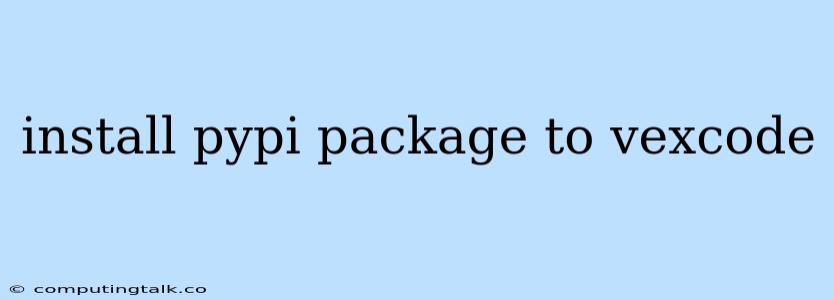Installing Python Packages in VEXcode
VEXcode, a powerful coding environment for VEX Robotics products, provides a user-friendly interface for programming robots using both block-based and text-based coding. While VEXcode offers a robust library of pre-installed functionalities, you might encounter situations where you need to leverage external Python packages to enhance your projects.
This article will guide you through the process of installing Python packages from the Python Package Index (PyPI) within the VEXcode environment.
Understanding PyPI and Python Packages
The PyPI (Python Package Index) is a vast repository hosting a wide variety of open-source Python packages. These packages, essentially pre-written code modules, offer a plethora of functionality, from data analysis and visualization to machine learning and robotics applications. By using PyPI packages, you can significantly extend VEXcode's capabilities and tackle complex tasks with ease.
Steps to Install Python Packages in VEXcode
1. Identify the Required Package:
First, identify the specific Python package you need for your VEXcode project. You can search for packages on the official PyPI website () or consult online resources.
2. Verify Python Version Compatibility:
It's crucial to ensure that the chosen Python package is compatible with the Python version used by VEXcode. VEXcode generally relies on Python 3.x; therefore, check the package's documentation to confirm its compatibility.
3. Install the Package Using pip:
The pip package installer is the standard way to install Python packages. You can access pip directly from the VEXcode terminal. Here's how to do it:
- Open the VEXcode Terminal: Click the "Terminal" icon on the VEXcode toolbar.
- Run the
pipInstallation Command: Use the following command to install your desired package:
Replacepip install<package_name>with the actual name of the Python package you want to install.
Example:
Let's say you want to install the numpy package for numerical computations. You would execute:
pip install numpy
4. Verify Installation:
After running the installation command, you can verify that the package has been successfully installed. Check the terminal output; if the installation was successful, it will display a confirmation message. You can also import the installed package into your VEXcode Python program to ensure it's available for use.
Example:
To verify the installation of numpy, you can include the following code snippet in your VEXcode Python program:
import numpy as np
If the code executes without errors, numpy is successfully installed.
5. Use the Package in Your VEXcode Project:
Once the package is installed, you can use its functionalities within your VEXcode program. Refer to the package's documentation for detailed usage instructions and examples.
Example:
import numpy as np
# Generate an array using numpy
my_array = np.arange(10)
# Perform calculations using the array
sum_of_elements = np.sum(my_array)
print(sum_of_elements)
Tips for Installing Packages in VEXcode
- Virtual Environments: For complex projects with multiple dependencies, consider using Python virtual environments to isolate your project's packages.
- Package Conflicts: If you encounter conflicts between different packages, try uninstalling problematic packages using
pip uninstall <package_name>. - Outdated Packages: Regularly update your installed packages to ensure you have the latest features and bug fixes. Use
pip install --upgrade <package_name>to upgrade a package.
Conclusion
Installing Python packages from PyPI in VEXcode allows you to expand the capabilities of your robotics projects. By leveraging the vast library of open-source packages, you can add functionalities like advanced data processing, sensor integration, and machine learning algorithms, taking your VEXcode creations to the next level.
